Economics Principles Assignment (TRI 3 2019) - Demand and Supply
VerifiedAdded on 2022/08/23
|10
|1365
|23
Homework Assignment
AI Summary
This economics assignment analyzes the effects of various events on the market for apples in Australia, considering demand and supply shifts. The assignment explores how changes in the price of substitutes (pears), advancements in production technology, and income levels impact market equilibrium. It illustrates these changes using demand and supply graphs, explaining the market adjustment process. The assignment also critiques a statement about garlic demand, distinguishing between shifts and movements along curves. Furthermore, it delves into price elasticity of demand, calculating it using the midpoint formula and explaining its implications for firm revenue. Finally, the assignment discusses profit-maximizing strategies for a company, comparing total revenue-total cost and marginal revenue-marginal cost approaches.
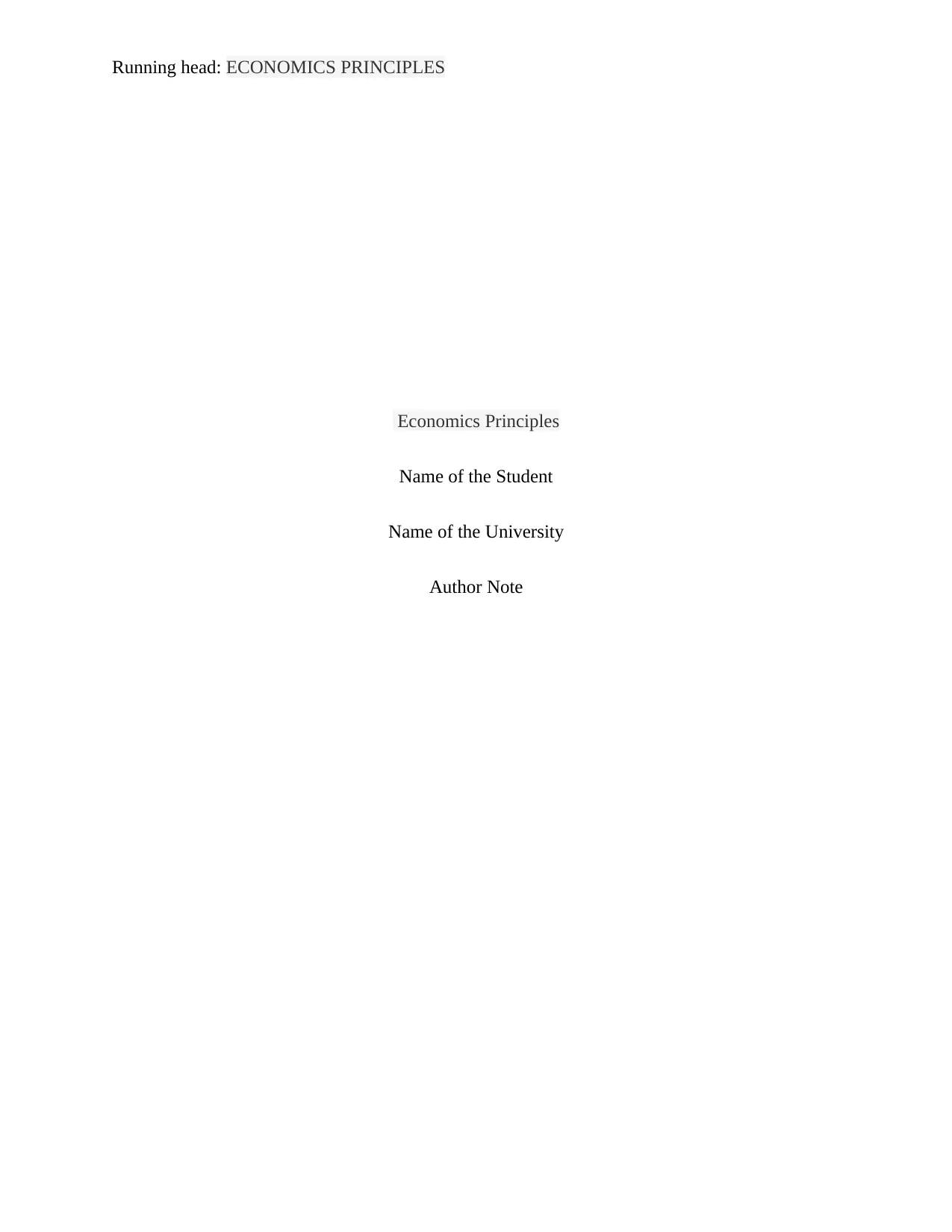
Running head: ECONOMICS PRINCIPLES
Economics Principles
Name of the Student
Name of the University
Author Note
Economics Principles
Name of the Student
Name of the University
Author Note
Paraphrase This Document
Need a fresh take? Get an instant paraphrase of this document with our AI Paraphraser
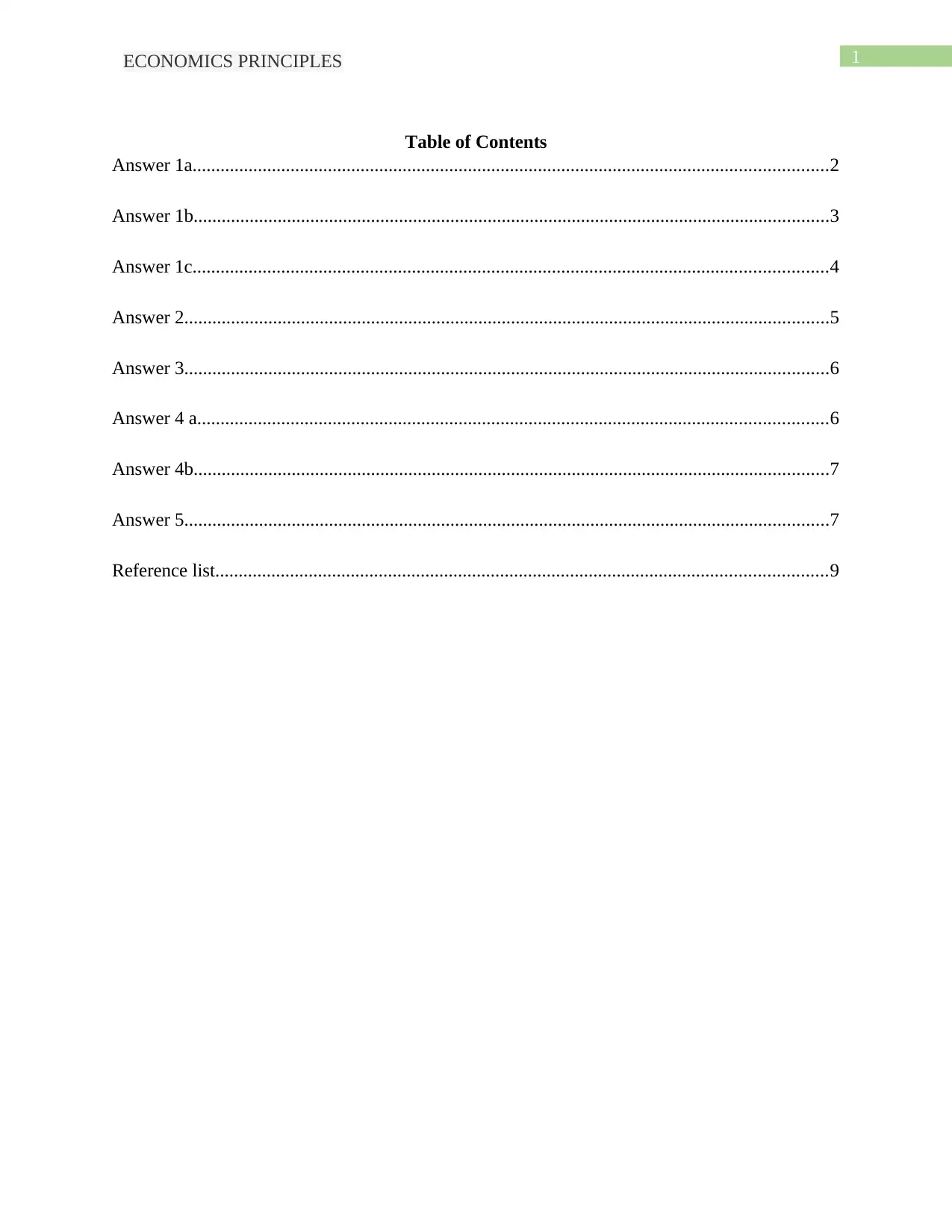
1ECONOMICS PRINCIPLES
Table of Contents
Answer 1a........................................................................................................................................2
Answer 1b........................................................................................................................................3
Answer 1c........................................................................................................................................4
Answer 2..........................................................................................................................................5
Answer 3..........................................................................................................................................6
Answer 4 a.......................................................................................................................................6
Answer 4b........................................................................................................................................7
Answer 5..........................................................................................................................................7
Reference list...................................................................................................................................9
Table of Contents
Answer 1a........................................................................................................................................2
Answer 1b........................................................................................................................................3
Answer 1c........................................................................................................................................4
Answer 2..........................................................................................................................................5
Answer 3..........................................................................................................................................6
Answer 4 a.......................................................................................................................................6
Answer 4b........................................................................................................................................7
Answer 5..........................................................................................................................................7
Reference list...................................................................................................................................9

2ECONOMICS PRINCIPLES
S
D2
D1
Output of apple
Price of apple
Q1 Q2
P1
P2 E2
E1
Answer 1a
Figure 1: Increase in pears price improves the demand for apple
Source: (as created by the author)
As per the statement, price of pears, a substitute of apples, increases. This intensifies the
market demand from D1 to D2, which in turn, raises the price level from P1 to P2 as supply of
apple remains constant. Henceforth, market equilibrium upgrades from E1 to E2.
S
D2
D1
Output of apple
Price of apple
Q1 Q2
P1
P2 E2
E1
Answer 1a
Figure 1: Increase in pears price improves the demand for apple
Source: (as created by the author)
As per the statement, price of pears, a substitute of apples, increases. This intensifies the
market demand from D1 to D2, which in turn, raises the price level from P1 to P2 as supply of
apple remains constant. Henceforth, market equilibrium upgrades from E1 to E2.
⊘ This is a preview!⊘
Do you want full access?
Subscribe today to unlock all pages.

Trusted by 1+ million students worldwide
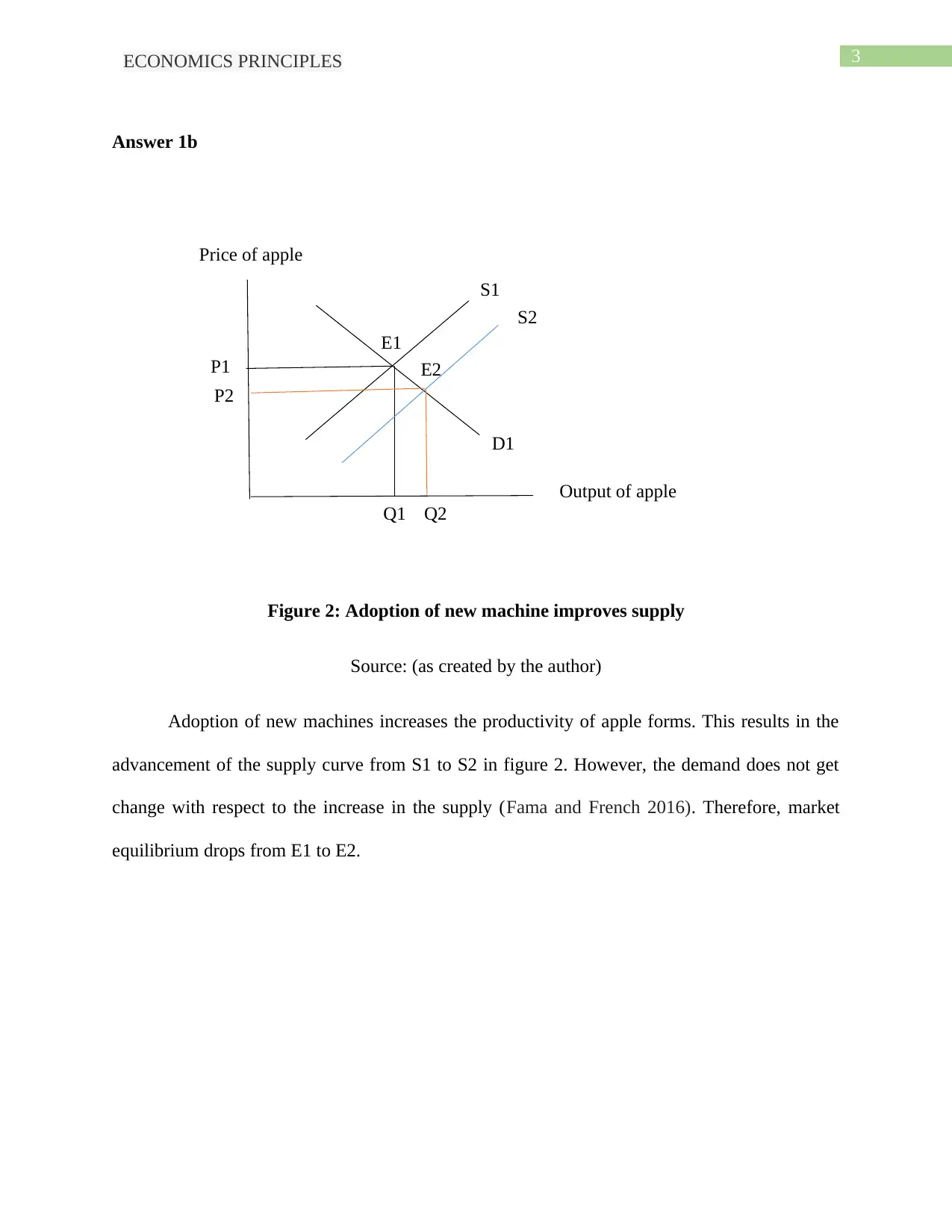
3ECONOMICS PRINCIPLES
S1
S2
D1
Output of apple
Price of apple
Q1 Q2
P1
P2
E1
E2
Answer 1b
Figure 2: Adoption of new machine improves supply
Source: (as created by the author)
Adoption of new machines increases the productivity of apple forms. This results in the
advancement of the supply curve from S1 to S2 in figure 2. However, the demand does not get
change with respect to the increase in the supply (Fama and French 2016). Therefore, market
equilibrium drops from E1 to E2.
S1
S2
D1
Output of apple
Price of apple
Q1 Q2
P1
P2
E1
E2
Answer 1b
Figure 2: Adoption of new machine improves supply
Source: (as created by the author)
Adoption of new machines increases the productivity of apple forms. This results in the
advancement of the supply curve from S1 to S2 in figure 2. However, the demand does not get
change with respect to the increase in the supply (Fama and French 2016). Therefore, market
equilibrium drops from E1 to E2.
Paraphrase This Document
Need a fresh take? Get an instant paraphrase of this document with our AI Paraphraser
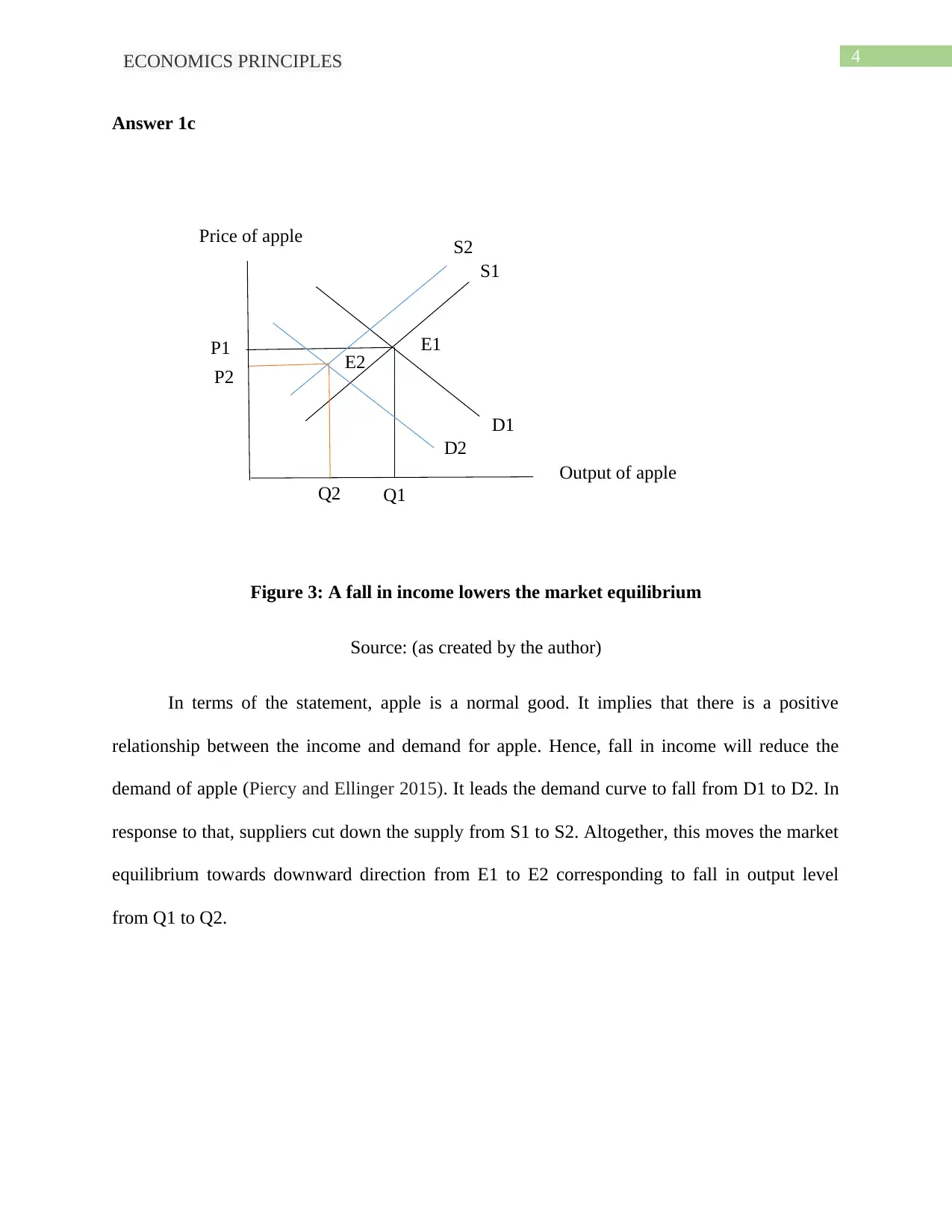
4ECONOMICS PRINCIPLES
S1
S2
D1
Output of apple
Price of apple
Q1Q2
P1
P2
E1
E2
D2
Answer 1c
Figure 3: A fall in income lowers the market equilibrium
Source: (as created by the author)
In terms of the statement, apple is a normal good. It implies that there is a positive
relationship between the income and demand for apple. Hence, fall in income will reduce the
demand of apple (Piercy and Ellinger 2015). It leads the demand curve to fall from D1 to D2. In
response to that, suppliers cut down the supply from S1 to S2. Altogether, this moves the market
equilibrium towards downward direction from E1 to E2 corresponding to fall in output level
from Q1 to Q2.
S1
S2
D1
Output of apple
Price of apple
Q1Q2
P1
P2
E1
E2
D2
Answer 1c
Figure 3: A fall in income lowers the market equilibrium
Source: (as created by the author)
In terms of the statement, apple is a normal good. It implies that there is a positive
relationship between the income and demand for apple. Hence, fall in income will reduce the
demand of apple (Piercy and Ellinger 2015). It leads the demand curve to fall from D1 to D2. In
response to that, suppliers cut down the supply from S1 to S2. Altogether, this moves the market
equilibrium towards downward direction from E1 to E2 corresponding to fall in output level
from Q1 to Q2.
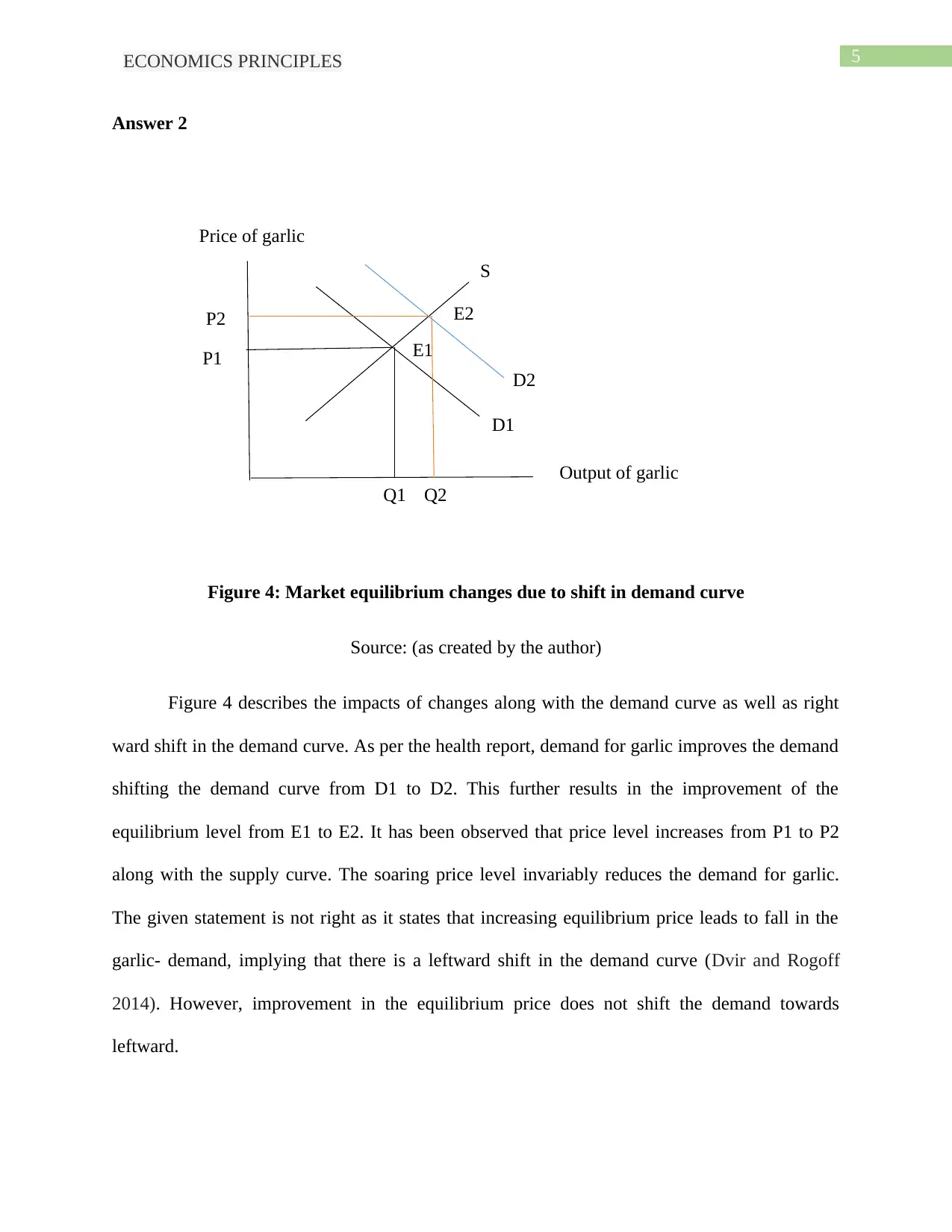
5ECONOMICS PRINCIPLES
S
D2
D1
Output of garlic
Price of garlic
Q1 Q2
P1
P2 E2
E1
Answer 2
Figure 4: Market equilibrium changes due to shift in demand curve
Source: (as created by the author)
Figure 4 describes the impacts of changes along with the demand curve as well as right
ward shift in the demand curve. As per the health report, demand for garlic improves the demand
shifting the demand curve from D1 to D2. This further results in the improvement of the
equilibrium level from E1 to E2. It has been observed that price level increases from P1 to P2
along with the supply curve. The soaring price level invariably reduces the demand for garlic.
The given statement is not right as it states that increasing equilibrium price leads to fall in the
garlic- demand, implying that there is a leftward shift in the demand curve (Dvir and Rogoff
2014). However, improvement in the equilibrium price does not shift the demand towards
leftward.
S
D2
D1
Output of garlic
Price of garlic
Q1 Q2
P1
P2 E2
E1
Answer 2
Figure 4: Market equilibrium changes due to shift in demand curve
Source: (as created by the author)
Figure 4 describes the impacts of changes along with the demand curve as well as right
ward shift in the demand curve. As per the health report, demand for garlic improves the demand
shifting the demand curve from D1 to D2. This further results in the improvement of the
equilibrium level from E1 to E2. It has been observed that price level increases from P1 to P2
along with the supply curve. The soaring price level invariably reduces the demand for garlic.
The given statement is not right as it states that increasing equilibrium price leads to fall in the
garlic- demand, implying that there is a leftward shift in the demand curve (Dvir and Rogoff
2014). However, improvement in the equilibrium price does not shift the demand towards
leftward.
⊘ This is a preview!⊘
Do you want full access?
Subscribe today to unlock all pages.

Trusted by 1+ million students worldwide
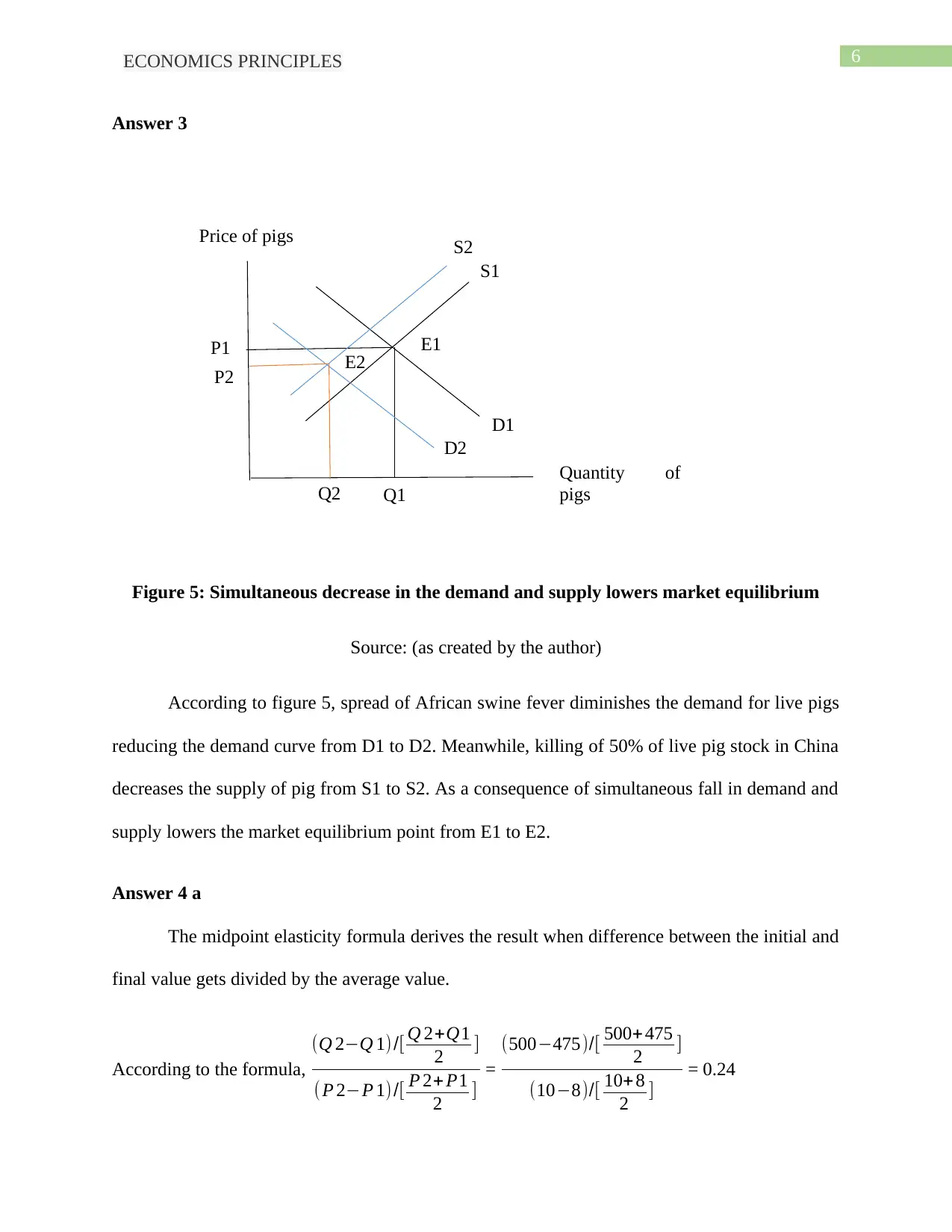
6ECONOMICS PRINCIPLES
S1
S2
D1
Quantity of
pigs
Price of pigs
Q1Q2
P1
P2
E1
E2
D2
Answer 3
Figure 5: Simultaneous decrease in the demand and supply lowers market equilibrium
Source: (as created by the author)
According to figure 5, spread of African swine fever diminishes the demand for live pigs
reducing the demand curve from D1 to D2. Meanwhile, killing of 50% of live pig stock in China
decreases the supply of pig from S1 to S2. As a consequence of simultaneous fall in demand and
supply lowers the market equilibrium point from E1 to E2.
Answer 4 a
The midpoint elasticity formula derives the result when difference between the initial and
final value gets divided by the average value.
According to the formula,
(Q 2−Q 1) /[ Q 2+Q1
2 ]
( P 2−P 1) /[ P 2+ P1
2 ]
=
(500−475)/[ 500+ 475
2 ]
(10−8)/[ 10+ 8
2 ]
= 0.24
S1
S2
D1
Quantity of
pigs
Price of pigs
Q1Q2
P1
P2
E1
E2
D2
Answer 3
Figure 5: Simultaneous decrease in the demand and supply lowers market equilibrium
Source: (as created by the author)
According to figure 5, spread of African swine fever diminishes the demand for live pigs
reducing the demand curve from D1 to D2. Meanwhile, killing of 50% of live pig stock in China
decreases the supply of pig from S1 to S2. As a consequence of simultaneous fall in demand and
supply lowers the market equilibrium point from E1 to E2.
Answer 4 a
The midpoint elasticity formula derives the result when difference between the initial and
final value gets divided by the average value.
According to the formula,
(Q 2−Q 1) /[ Q 2+Q1
2 ]
( P 2−P 1) /[ P 2+ P1
2 ]
=
(500−475)/[ 500+ 475
2 ]
(10−8)/[ 10+ 8
2 ]
= 0.24
Paraphrase This Document
Need a fresh take? Get an instant paraphrase of this document with our AI Paraphraser
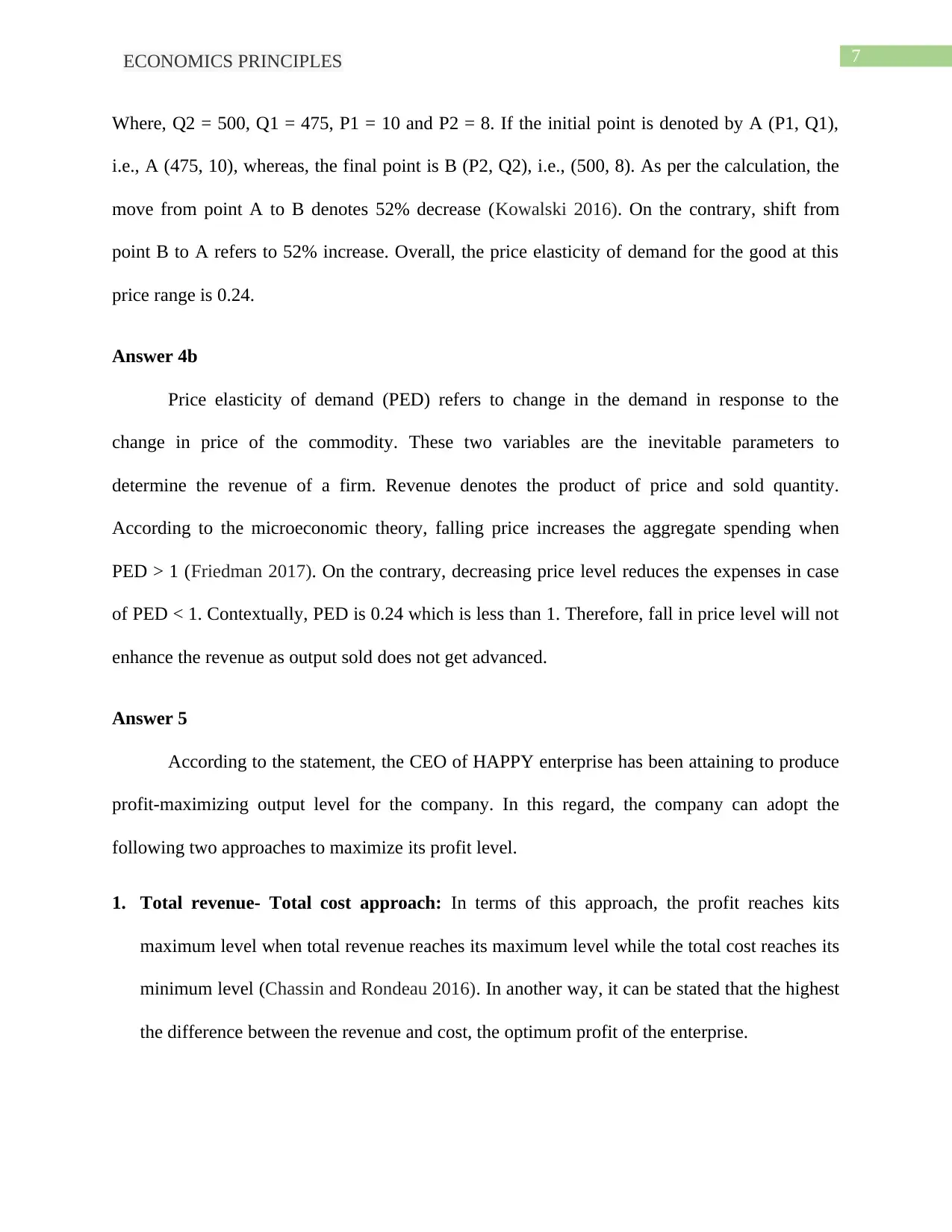
7ECONOMICS PRINCIPLES
Where, Q2 = 500, Q1 = 475, P1 = 10 and P2 = 8. If the initial point is denoted by A (P1, Q1),
i.e., A (475, 10), whereas, the final point is B (P2, Q2), i.e., (500, 8). As per the calculation, the
move from point A to B denotes 52% decrease (Kowalski 2016). On the contrary, shift from
point B to A refers to 52% increase. Overall, the price elasticity of demand for the good at this
price range is 0.24.
Answer 4b
Price elasticity of demand (PED) refers to change in the demand in response to the
change in price of the commodity. These two variables are the inevitable parameters to
determine the revenue of a firm. Revenue denotes the product of price and sold quantity.
According to the microeconomic theory, falling price increases the aggregate spending when
PED > 1 (Friedman 2017). On the contrary, decreasing price level reduces the expenses in case
of PED < 1. Contextually, PED is 0.24 which is less than 1. Therefore, fall in price level will not
enhance the revenue as output sold does not get advanced.
Answer 5
According to the statement, the CEO of HAPPY enterprise has been attaining to produce
profit-maximizing output level for the company. In this regard, the company can adopt the
following two approaches to maximize its profit level.
1. Total revenue- Total cost approach: In terms of this approach, the profit reaches kits
maximum level when total revenue reaches its maximum level while the total cost reaches its
minimum level (Chassin and Rondeau 2016). In another way, it can be stated that the highest
the difference between the revenue and cost, the optimum profit of the enterprise.
Where, Q2 = 500, Q1 = 475, P1 = 10 and P2 = 8. If the initial point is denoted by A (P1, Q1),
i.e., A (475, 10), whereas, the final point is B (P2, Q2), i.e., (500, 8). As per the calculation, the
move from point A to B denotes 52% decrease (Kowalski 2016). On the contrary, shift from
point B to A refers to 52% increase. Overall, the price elasticity of demand for the good at this
price range is 0.24.
Answer 4b
Price elasticity of demand (PED) refers to change in the demand in response to the
change in price of the commodity. These two variables are the inevitable parameters to
determine the revenue of a firm. Revenue denotes the product of price and sold quantity.
According to the microeconomic theory, falling price increases the aggregate spending when
PED > 1 (Friedman 2017). On the contrary, decreasing price level reduces the expenses in case
of PED < 1. Contextually, PED is 0.24 which is less than 1. Therefore, fall in price level will not
enhance the revenue as output sold does not get advanced.
Answer 5
According to the statement, the CEO of HAPPY enterprise has been attaining to produce
profit-maximizing output level for the company. In this regard, the company can adopt the
following two approaches to maximize its profit level.
1. Total revenue- Total cost approach: In terms of this approach, the profit reaches kits
maximum level when total revenue reaches its maximum level while the total cost reaches its
minimum level (Chassin and Rondeau 2016). In another way, it can be stated that the highest
the difference between the revenue and cost, the optimum profit of the enterprise.
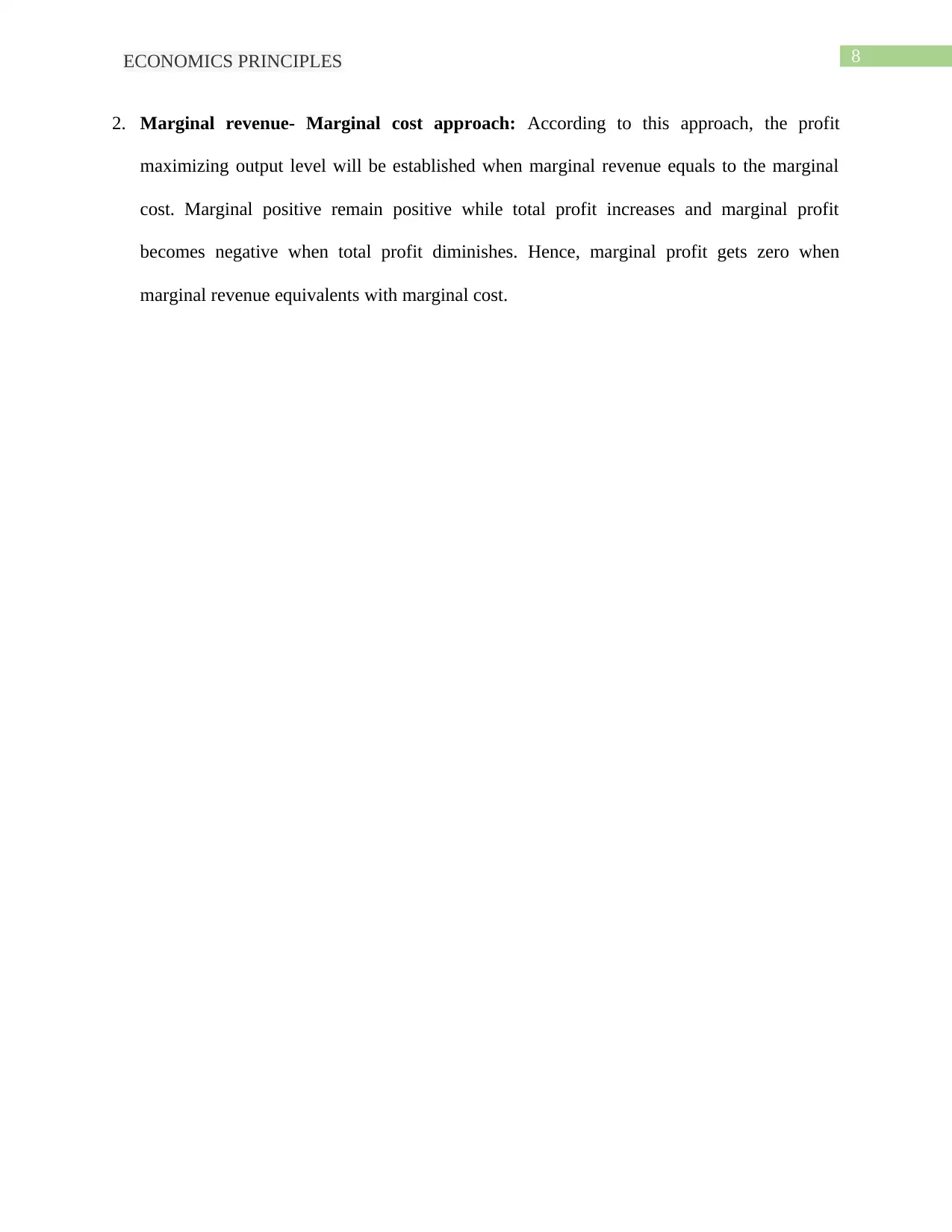
8ECONOMICS PRINCIPLES
2. Marginal revenue- Marginal cost approach: According to this approach, the profit
maximizing output level will be established when marginal revenue equals to the marginal
cost. Marginal positive remain positive while total profit increases and marginal profit
becomes negative when total profit diminishes. Hence, marginal profit gets zero when
marginal revenue equivalents with marginal cost.
2. Marginal revenue- Marginal cost approach: According to this approach, the profit
maximizing output level will be established when marginal revenue equals to the marginal
cost. Marginal positive remain positive while total profit increases and marginal profit
becomes negative when total profit diminishes. Hence, marginal profit gets zero when
marginal revenue equivalents with marginal cost.
⊘ This is a preview!⊘
Do you want full access?
Subscribe today to unlock all pages.

Trusted by 1+ million students worldwide
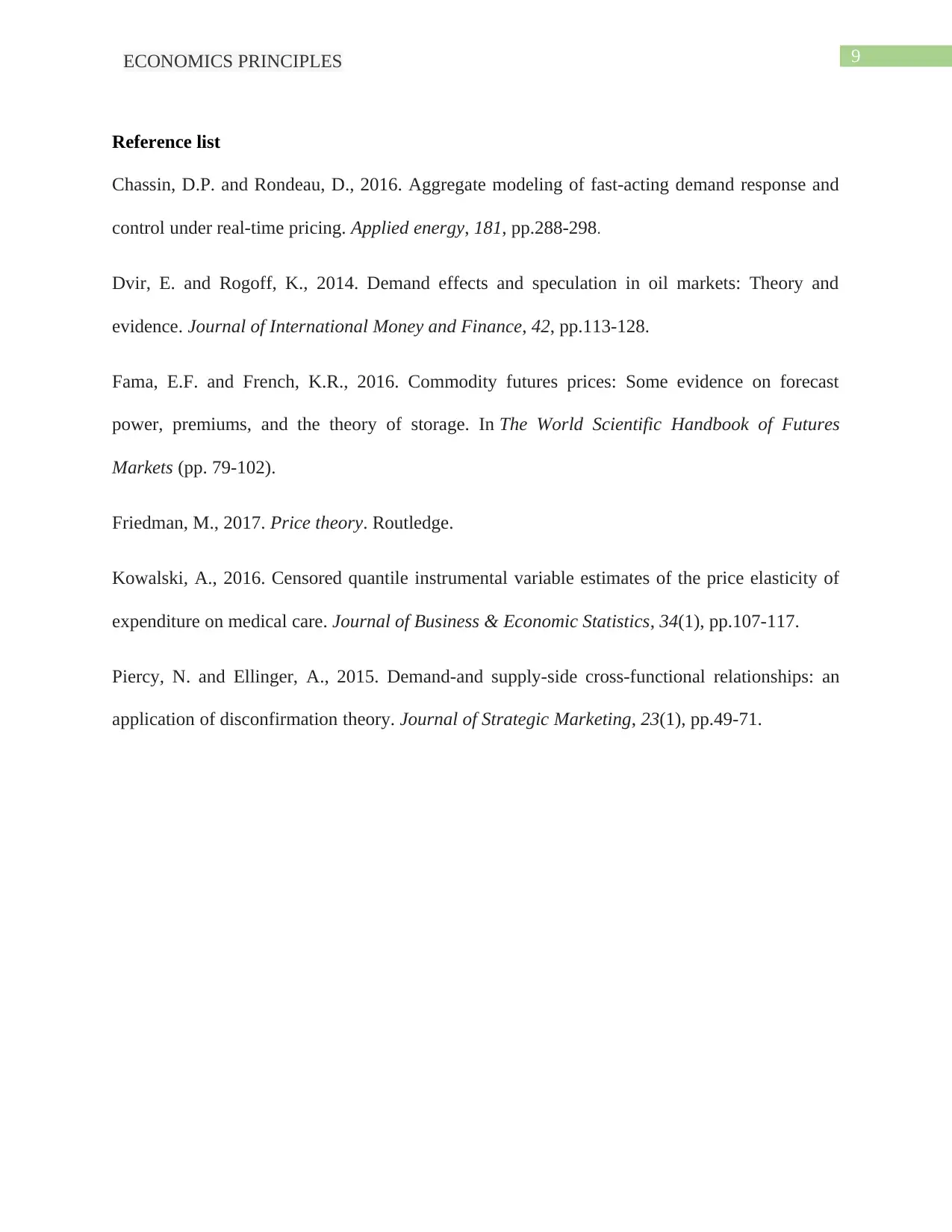
9ECONOMICS PRINCIPLES
Reference list
Chassin, D.P. and Rondeau, D., 2016. Aggregate modeling of fast-acting demand response and
control under real-time pricing. Applied energy, 181, pp.288-298.
Dvir, E. and Rogoff, K., 2014. Demand effects and speculation in oil markets: Theory and
evidence. Journal of International Money and Finance, 42, pp.113-128.
Fama, E.F. and French, K.R., 2016. Commodity futures prices: Some evidence on forecast
power, premiums, and the theory of storage. In The World Scientific Handbook of Futures
Markets (pp. 79-102).
Friedman, M., 2017. Price theory. Routledge.
Kowalski, A., 2016. Censored quantile instrumental variable estimates of the price elasticity of
expenditure on medical care. Journal of Business & Economic Statistics, 34(1), pp.107-117.
Piercy, N. and Ellinger, A., 2015. Demand-and supply-side cross-functional relationships: an
application of disconfirmation theory. Journal of Strategic Marketing, 23(1), pp.49-71.
Reference list
Chassin, D.P. and Rondeau, D., 2016. Aggregate modeling of fast-acting demand response and
control under real-time pricing. Applied energy, 181, pp.288-298.
Dvir, E. and Rogoff, K., 2014. Demand effects and speculation in oil markets: Theory and
evidence. Journal of International Money and Finance, 42, pp.113-128.
Fama, E.F. and French, K.R., 2016. Commodity futures prices: Some evidence on forecast
power, premiums, and the theory of storage. In The World Scientific Handbook of Futures
Markets (pp. 79-102).
Friedman, M., 2017. Price theory. Routledge.
Kowalski, A., 2016. Censored quantile instrumental variable estimates of the price elasticity of
expenditure on medical care. Journal of Business & Economic Statistics, 34(1), pp.107-117.
Piercy, N. and Ellinger, A., 2015. Demand-and supply-side cross-functional relationships: an
application of disconfirmation theory. Journal of Strategic Marketing, 23(1), pp.49-71.
1 out of 10
Related Documents
Your All-in-One AI-Powered Toolkit for Academic Success.
+13062052269
info@desklib.com
Available 24*7 on WhatsApp / Email
![[object Object]](/_next/static/media/star-bottom.7253800d.svg)
Unlock your academic potential
Copyright © 2020–2025 A2Z Services. All Rights Reserved. Developed and managed by ZUCOL.




